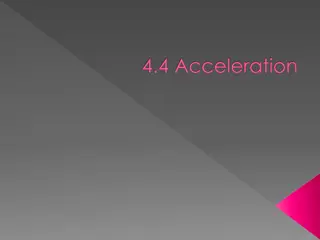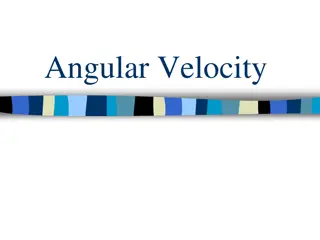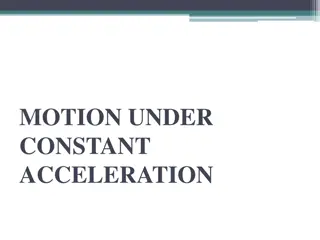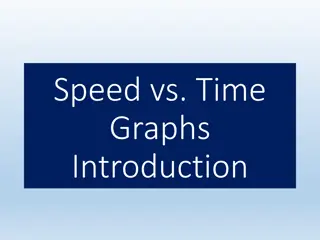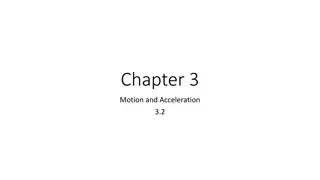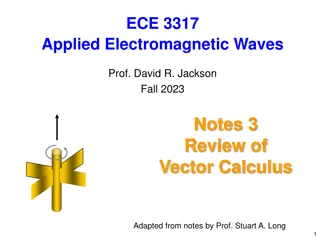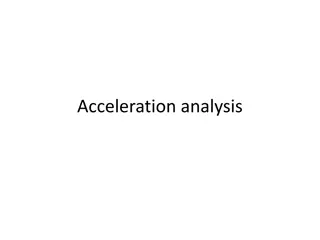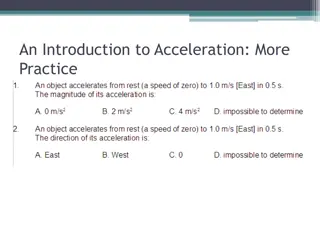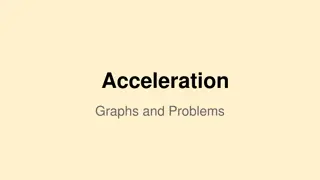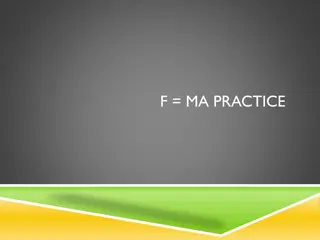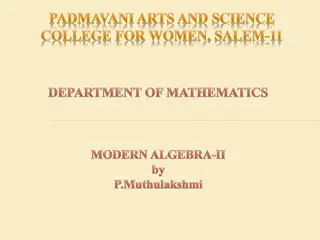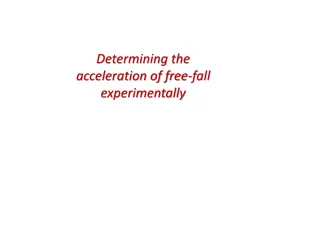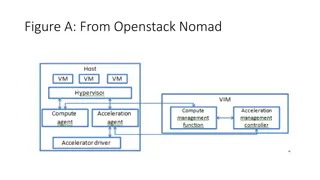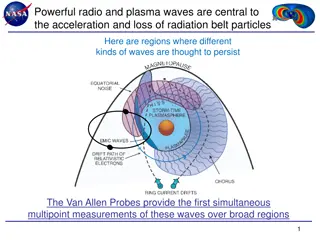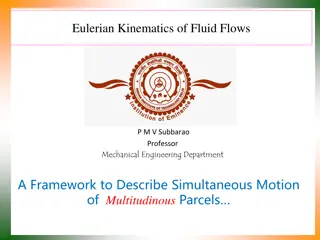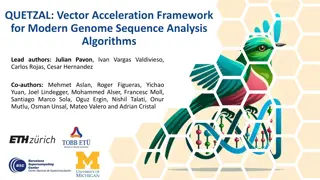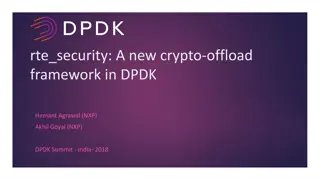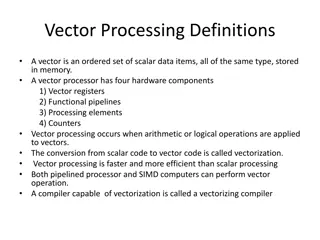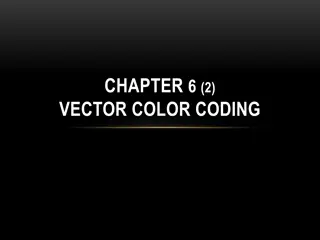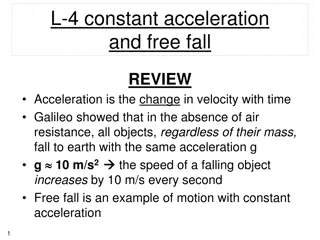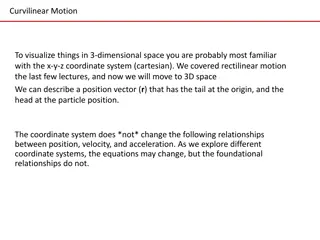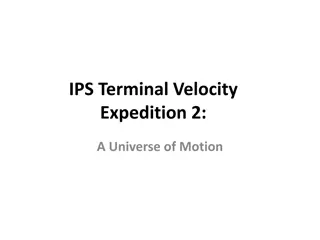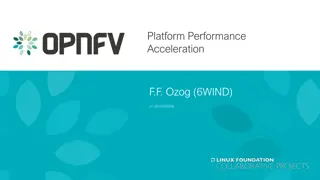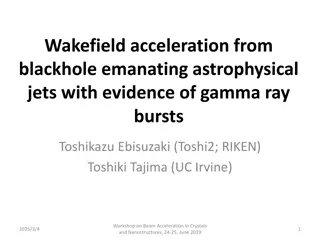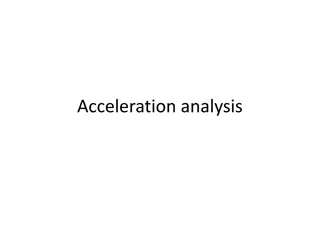Normed Vector Spaces for Nanotechnology Engineering
Introduction to normed vector spaces, focusing on defining norms for vectors in finite-dimensional spaces, exploring different ways to measure vector length, and understanding the concept of unit vectors and norm properties. This topic equips readers with the ability to calculate vector norms, norma
2 views • 9 slides
Acceleration in Physics
Acceleration is the rate at which velocity changes, encompassing both increases and decreases in speed. In physics, acceleration is defined as the rate of change in velocity, making it a vector quantity due to its directional nature. This article explores the concept of acceleration, including examp
2 views • 15 slides
Rotational Motion: Angular Velocity and Acceleration
Explore the concepts of angular velocity, radians, and rotational motion in this educational content. Learn about the relationship between angular and linear velocity, angular acceleration, tangential acceleration, and centripetal acceleration through practical examples. Enhance your understanding o
7 views • 17 slides
Motion Under Constant Acceleration
Constant acceleration refers to motion where the speed increases by the same amount each second. It is exemplified in scenarios like free fall due to gravity, where objects experience a consistent acceleration of approximately 10 meters per second squared. This type of motion plays a significant rol
5 views • 11 slides
Speed vs. Time Graphs: Analyzing Acceleration and Motion
Explore the concept of speed vs. time graphs and learn how to recognize acceleration, interpret speed, analyze motion, and calculate acceleration from the slope of the graph. Discover the characteristics of graphs showing constant acceleration, varying acceleration, and deceleration. Engage in drawi
3 views • 19 slides
Acceleration in Motion: Concepts and Examples
Delve into the world of acceleration in motion with this informative content. Learn how acceleration is defined, its relationship with velocity, and the different types of acceleration - positive, negative, and zero. Examples like a car at a stoplight, a bouncing ball, and a jet airliner on a runway
4 views • 8 slides
Overview of Vector Calculus for ECE 3317 Course
This overview provides a brief explanation of vector calculus concepts essential for the ECE 3317 course on Applied Electromagnetic Waves. It covers del operator, gradient, divergence, curl, vector Laplacian, vector identities, and their applications in electromagnetic field theory.
5 views • 24 slides
Acceleration Analysis of Slider Crank Mechanism
In this analysis, we calculate the acceleration of the slider at point B, acceleration of point E, and the angular acceleration of the link AB in a slider crank mechanism. The steps involve drawing configuration, velocity, and acceleration diagrams with suitable scales to determine the necessary par
6 views • 12 slides
Acceleration and Gravity in Physics
Explore the concepts of acceleration and gravity in physics through engaging images and key points. Learn about mass, weight, Newton's Law of Gravitational Attraction, and the acceleration due to Earth's gravity. Discover how all objects fall at the same rate regardless of mass and what factors can
5 views • 31 slides
Acceleration in Physics
Explore the concept of acceleration through real-world scenarios involving moving objects and graphs. Learn how to determine the direction of acceleration based on the velocity changes of cars, divers, bungee jumpers, and more. Delve into examples of calculating average acceleration and final veloci
1 views • 11 slides
Effect of Weighted Sled Towing and Weighted Vest on Sprinter Acceleration Performance
Short distance running involves crucial phases affecting sprint performance, with acceleration being particularly important. Training methods like weighted sled towing and weighted vest usage have been found effective in enhancing sprint acceleration. This study investigated the impact of these meth
5 views • 8 slides
Mechanics Practice Problems with Force and Acceleration
Solve practice problems involving force, mass, and acceleration in physics. Calculate net force accelerating a bicycle, mass of the Space Shuttle based on thrust and acceleration, acceleration of a runner given force and mass, and acceleration of a car with a known force and mass.
4 views • 5 slides
Fundamental Concepts in Vector Spaces and Inner Product Spaces
A vector space over a field F is characterized by operations such as addition and scalar multiplication. Subspaces, direct sums, linear combinations, linear spans, dimensions, and dual spaces are fundamental concepts in vector spaces. Moving into inner product spaces, the concept of inner products,
5 views • 13 slides
Experimental Determination of Acceleration of Free Fall
Experimentally determining the acceleration of free fall by analyzing the motion of an apple and a feather falling in a vacuum. By scaling and analyzing the data, the acceleration is calculated to be approximately 9.82 m/s^2, indicating a constant acceleration due to gravity.
3 views • 13 slides
Acceleration Management Architectures in OpenStack Nomad and DPACC
The figures depict the architecture of Software Acceleration Layer (SAL), Acceleration Management Layer (AML), and other components in OpenStack Nomad and DPACC. They illustrate the interaction between Software Routing Layer (SRL), General Drivers (g-drivers), Hardware I/O Interface (hio), and more
6 views • 4 slides
Unveiling the Role of Radio and Plasma Waves in Particle Acceleration
Radio and plasma waves play a crucial role in the acceleration and loss of radiation belt particles. The Van Allen Probes provide groundbreaking multipoint measurements of these waves in various regions, shedding light on phenomena such as chorus waves and resonant wave acceleration. Strong correlat
4 views • 8 slides
Material Derivative in Fluid Mechanics
Fluid flows are described using Eulerian kinematics and material derivative concepts, highlighting the changes in scalar and vector fields. The acceleration and components of material acceleration are explored, along with visualizations of material acceleration. Trajectories and displacements of flu
7 views • 13 slides
QUETZAL: Vector Acceleration Framework for Modern Genome Sequence Analysis Algorithms
QUETZAL is a hardware-software co-designed vector acceleration framework that significantly outperforms other algorithms in genome sequence analysis. It offers high performance and energy efficiency, capable of accelerating both modern and classical algorithms. With features like custom hardware and
2 views • 5 slides
New Crypto Offload Framework in DPDK - Security Acceleration Overview
This content delves into a new crypto offload framework within DPDK, emphasizing security acceleration through various protocols and hardware acceleration modes like Lookaside and Inline Crypto. The comprehensive agenda covers introduction, encryption packet processing, and lookaside protocol accele
5 views • 26 slides
Vector Processing Definitions
A vector in computing is an ordered set of scalar data items, processed efficiently by vector processors using hardware components like vector registers and functional pipelines. Learn about vectorization, vector stride, and various types of vector instructions for faster and more efficient data pro
4 views • 13 slides
Vector Color Coding and Displacement Plots in Vector Fields
Explore vector color coding and displacement plots in vector fields to visualize trajectories and surface warping. Understand the representation of vectors in terms of orientation, magnitude, and surfaces in a visually continuous manner. Discover the use of stream objects to display trajectories at
2 views • 34 slides
Constant Acceleration and Free Fall
Acceleration is the rate of change in velocity with time. In free fall, all objects fall to Earth with the same acceleration regardless of mass. This review covers motion with constant acceleration, including examples and explanations of velocity changes and simple cases with zero acceleration.
4 views • 21 slides
Curvilinear Motion in 3D Space
curvilinear motion in 3D space involves describing particle position using a position vector, exploring relationships between position, velocity, and acceleration, and visualizing motion through coordinate systems. This concept delves into position vectors, displacement, velocity - both average and
3 views • 16 slides
Unveiling Motion in the Universe
Delve into motion relative to reference points, scalar versus vector quantities, and interpreting motion graphs. Explore speed, velocity, acceleration, and momentum connections. Analyze crash tests with the Law of Conservation of Momentum. Understand instantaneous speed, concept of velocity as a vec
3 views • 24 slides
Platform Performance Acceleration of VM Binary Compatibility
This content discusses the platform performance acceleration by implementing VM binary compatibility through hardware and software accelerators. It covers the development of extensible para-virtualized devices, DPDK/ODP acceleration library, and specific software accelerators. The images provided il
1 views • 13 slides
Vector Operations: Addition, Resolution, and Multiplication
Fundamentals of vectors in Chapter 3, covering addition of vectors, resolution of vectors, and multiplication through scalar and vector products. Dive into concepts like negative and positive directions, unit vectors, vector notation, and examples illustrating vector operations in one dimension alon
0 views • 51 slides
Acceleration Concepts
Acceleration is defined as the rate of change of velocity, indicating how quickly an object's velocity changes. Learn about units of acceleration, direction conventions, and solve acceleration problems with examples provided.
2 views • 11 slides
Vectors: Finding Vector Components
Explore the definition of vector components and how to find them. Discover the components of vectors and learn how to write the notation for vector components. Follow along with informative whiteboard illustrations to understand vector components visually. Practice drawing components from the tail t
1 views • 23 slides
Wakefield Acceleration from Black Hole Emanating Astrophysical Jets
Study on Wakefield acceleration from black hole emanating astrophysical jets revealing evidence of gamma-ray bursts at a workshop on Beam Acceleration in Crystals and Nanostructures. The workshop covers topics such as ultra-high energy cosmic rays, bow wake acceleration, future cosmic-ray observatio
0 views • 52 slides
Centripetal Acceleration in Circular Motion
Centripetal acceleration plays a crucial role in circular motion by indicating the rate of change in velocity and direction of an object. This acceleration is always perpendicular to the velocity, pointing towards the center of the curve. Without centripetal force, objects would move in a straight l
1 views • 12 slides
Vector Processing and SIMD Architectures in Modern CPUs
This content delves into the concept of vector processing and SIMD architectures in modern CPUs, focusing on Intel's instruction set extensions like MMX, SSE, AVX, and AVX512. It explains how SIMD architectures enable parallel processing of data, leading to enhanced performance for vector operations
3 views • 19 slides
Acceleration in Motion Studies
Learn about acceleration in motion studies - the rate at which velocity changes with time, the impact of speed and direction changes, calculations of average acceleration, and the relationship between velocity and acceleration. Explore constant acceleration equations and analyze position-time graphs
4 views • 13 slides
Velocity and Acceleration Analysis of Four-Bar Chain Mechanism
Explore the velocity and acceleration diagrams of a four-bar chain mechanism with detailed step-by-step analysis. Learn about angular velocity, angular acceleration, radial acceleration, and tangential acceleration of the chain links.
0 views • 8 slides
Plasma Mirrors for Laser Wakefield Acceleration Study
This study explores the use of plasma mirrors for laser wakefield acceleration, demonstrating ionisation injection driven by a reflected pulse and investigating reductions in reflectivity through simulations. The experiment with Gemini staging in 2024 showcases electron acceleration and energy gain
6 views • 2 slides
Laser-Plasma Acceleration Workshop Highlights Cutting-Edge Research
Explore the latest advancements in laser-plasma acceleration from the Laser-Plasma Acceleration Workshop in Ischia. Discover how LWIR lasers and other technologies are revolutionizing electron acceleration and driving innovations in free-electron lasers, plasma bubbles, and more.
2 views • 23 slides
Speed, Acceleration, and Equations of Motion in Physics
Explore the concepts of speed, acceleration, and equations of motion in physics through practical examples and mathematical skills. Learn how to define speed, rearrange equations, obtain acceleration from velocity-time graphs, and calculate acceleration using the relevant equation.
3 views • 18 slides
Constant Acceleration and Motion Equations
Learn about constant acceleration, motion under gravity, and how to calculate distance, acceleration, time, and velocity with worked examples. Explore chapters on acceleration formulas and derive key equations for motion.
2 views • 21 slides
Velocity and Acceleration Analysis of Mechanisms
This content covers the velocity and acceleration analysis of mechanisms, specifically focusing on components of acceleration, tangential component, and normal component along a circular path. It explains how to calculate tangential and normal acceleration, emphasizing their significance in understa
5 views • 9 slides
An Overview of Vector Processing in Modern CPUs
SIMD architectures play a crucial role in enhancing the performance of vector operations in contemporary CPUs, with Intel's MMX, SSE, AVX, AVX2, and AVX512 extensions catering to data parallelism. Vector operations involve vector addition, scaling, and dot product computation, providing improved eff
1 views • 19 slides
Uniform Acceleration Equations Derivation
Explore the derivation of uniform acceleration equations in physics, including velocity, displacement, and acceleration calculations. Understand the integration process and how vectors play a role in determining velocity and acceleration. Dive into the fundamental concepts of motion and how calculus
1 views • 47 slides

